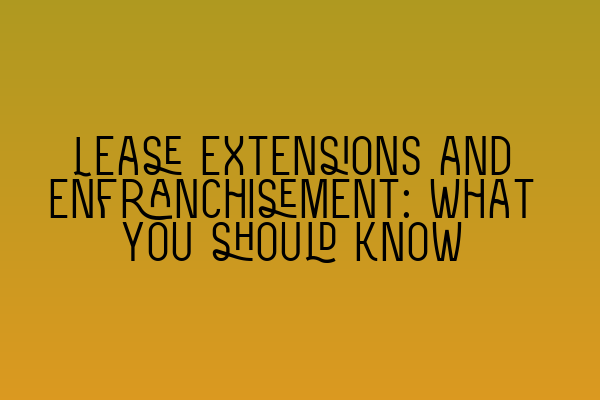Lease Extensions and Enfranchisement: What You Should Know
If you are a leaseholder or a freeholder, understanding the intricacies of lease extensions and enfranchisement is crucial. These legal concepts can have a significant impact on your rights as a property owner. In this blog post, we will explore these two areas of property law in detail, ensuring that you have the knowledge you need to protect your interests.
What is a Lease Extension?
A lease extension is the process through which a leaseholder gains an extended lease term beyond the original lease period. This extension provides security of tenure and can increase the value of the property. It allows the leaseholder to continue occupying the property while enjoying the benefits of ownership.
Why Should You Consider a Lease Extension?
There are several reasons why you should consider a lease extension:
1. Increased Property Value: A property with a longer lease term is generally more attractive to potential buyers, increasing its market value.
2. Avoiding Ground Rent Escalation: Many leasehold properties have ground rent provisions that escalate over time. By extending the lease, you can avoid these increasing costs.
3. Security of Tenure: A lease extension provides the leaseholder with the certainty of knowing they can remain in the property, offering peace of mind and stability.
4. Potential for Remortgaging: Some lenders are reluctant to provide mortgages for properties with short lease terms. Extending the lease can open up better financing options.
How Does the Lease Extension Process Work?
The lease extension process can be complex, and seeking professional advice from a property solicitor is essential. However, I will outline the general steps involved:
1. Check Eligibility: Ensure that you meet the qualifying criteria for a lease extension. Generally, you must have owned the lease for at least two years and have a lease term of more than 21 years.
2. Serve a Section 42 Notice: This formal notice informs the freeholder of your intention to extend the lease. It includes the proposed price and terms. Seeking valuation advice is crucial at this stage.
3. Negotiate the Terms: Once the freeholder receives the Section 42 Notice, negotiations regarding the premium and other terms will take place. This is where having an experienced property solicitor on your side can be invaluable.
4. Agree on Terms: If both parties agree on the terms, a lease extension deed is prepared and executed, formalizing the extended lease.
5. Register the Lease Extension: It is important to register the lease extension with the Land Registry to ensure its legal validity.
What is Enfranchisement?
Enfranchisement is the process through which leaseholders of flats collectively purchase the freehold of their building or individual leaseholders acquire the right to manage their building through a process known as leasehold enfranchisement. This process offers leaseholders greater control over their properties and can significantly impact their rights and financial commitments.
Why Should You Consider Enfranchisement?
Enfranchisement offers several benefits to leaseholders:
1. Control over Building Management: By becoming the collective freeholder, leaseholders can make decisions about the management and maintenance of their building, giving them greater control and influence over its future.
2. Elimination of Ground Rent: Once the building is collectively owned, leaseholders are no longer required to pay ground rent, often resulting in substantial savings over time.
3. Increase in Property Value: Owning a share of the freehold can enhance the value of your property, making it more appealing to potential buyers.
4. Extended Lease Terms: Enfranchising leaseholders can agree to extend the lease terms for all flats within the building, further safeguarding their investments.
What is the Enfranchisement Process?
The enfranchisement process can vary depending on the specific circumstances, but it generally involves the following steps:
1. Form a Group: Leaseholders within the building must organize themselves into a group known as a “Right to Enfranchise” company or a “Right to Manage” company.
2. Serve a Notice: The group must serve a formal notice on the freeholder expressing their intention to purchase the freehold or acquire the right to manage, along with the proposed price and terms.
3. Valuation and Negotiation: Valuation advice should be sought to determine the premium payable for acquiring the freehold or right to manage. Negotiations will then take place to agree on the purchase price and terms.
4. Completing the Purchase: Once the terms have been agreed upon, the leaseholders will complete the purchase of the freehold or the right to manage. This involves the exchange of contracts and completion of the transaction.
5. Updating Titles and Management: The Land Registry will need to be updated to reflect the change in ownership, and the new freeholder or right to manage company will take over the management responsibilities.
Conclusion
Lease extensions and enfranchisement are critical areas of property law that can have a substantial impact on your rights and financial interests as a leaseholder or freeholder. Understanding the processes involved and seeking professional advice from a property solicitor is vital to navigate these complexities successfully.
At SQE Property Law & Land Law, our team of expert solicitors specializes in lease extensions, enfranchisement, and other property-related matters. Contact us today to explore your options and ensure that your property interests are protected.
Related Articles:
– SQE 1 Practice Exam Questions
– SQE 1 Practice Mocks FLK1 FLK2
– SQE 2 Preparation Courses
– SQE 1 Preparation Courses
– SRA SQE Exam Dates
